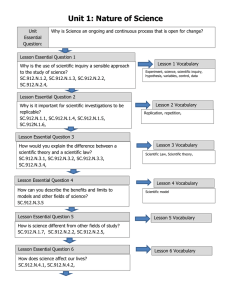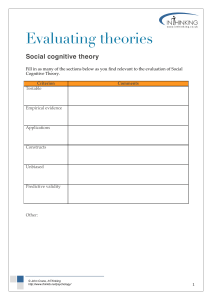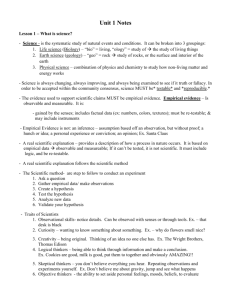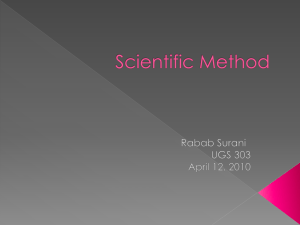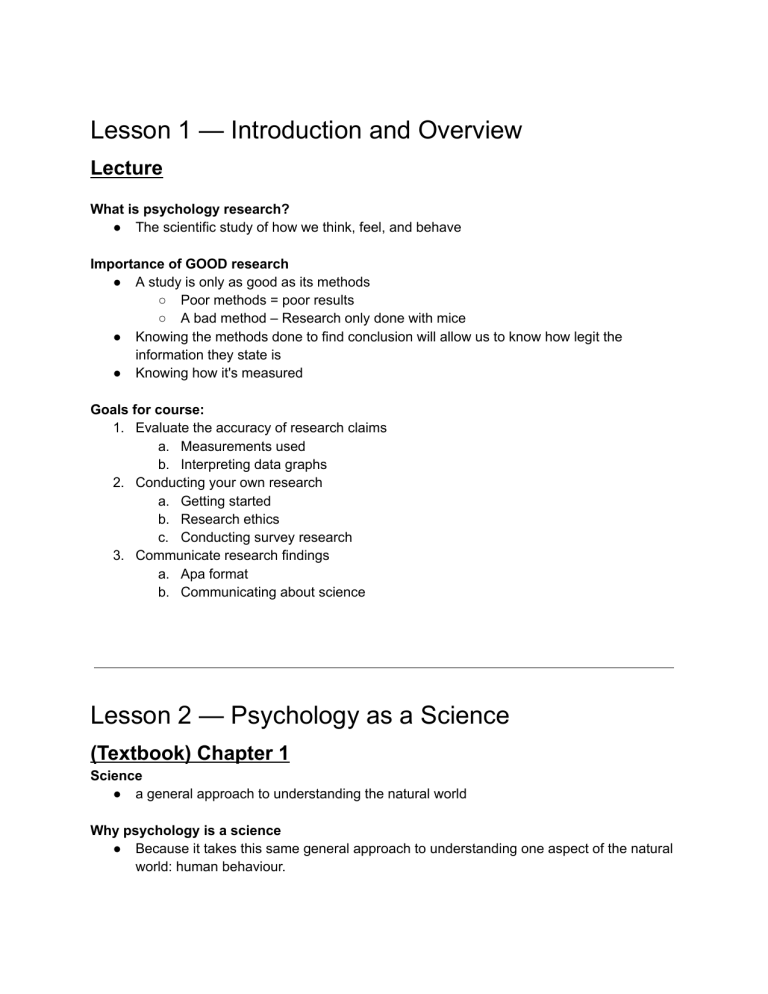
Lesson 1 — Introduction and Overview Lecture What is psychology research? ● The scientific study of how we think, feel, and behave Importance of GOOD research ● A study is only as good as its methods ○ Poor methods = poor results ○ A bad method – Research only done with mice ● Knowing the methods done to find conclusion will allow us to know how legit the information they state is ● Knowing how it's measured Goals for course: 1. Evaluate the accuracy of research claims a. Measurements used b. Interpreting data graphs 2. Conducting your own research a. Getting started b. Research ethics c. Conducting survey research 3. Communicate research findings a. Apa format b. Communicating about science Lesson 2 — Psychology as a Science (Textbook) Chapter 1 Science ● a general approach to understanding the natural world Why psychology is a science ● Because it takes this same general approach to understanding one aspect of the natural world: human behaviour. The three fundamental features of science: 1. Systematic Empiricism a. Science is based on empiricism, which means learning from observations. Scientists observe the natural world systematically through careful planning, recording, and analysis. b. Example*: Mehl and his colleagues tested the stereotype about whether women talk more than men. Instead of relying on casual observations or existing stereotypes, they conducted systematic observations by recording, counting, and comparing the number of words spoken by a large sample of men and women. c. Significance: Systematic empiricism emphasizes the importance of evidence-based knowledge and the need for rigorous testing of hypotheses or ideas against empirical observations. 2. Empirical Questions a. Definition: Science is concerned with questions about the actual state of the world, which can be answered through systematic observation. These questions are termed "empirical questions." b. Example*: The question of whether women speak more than men is empirical. It can be answered by observing and measuring. However, questions about values or judgments, such as whether it's wrong for people to have inaccurate stereotypes, are not empirical and thus fall outside the scope of scientific investigation. c. Significance*: It's crucial for science to maintain a clear boundary between what can be empirically tested and what cannot be. This ensures that scientific conclusions are drawn based on observable and measurable phenomena. 3. Public Knowledge a. Definition: Scientists publish their findings, making science a public enterprise. This creates a collective, shared body of knowledge that is accessible and can be built upon by others. b. Example*: The "Many Labs Replication Project" where a group of scientists around the world tried to replicate findings from various studies. This project and its results were made public, showcasing the collaborative nature of science and its self-correcting mechanism. c. Significance: Publication ensures that science is a collective effort that grows over time, and can be self-corrected, ensuring that science becomes increasingly accurate and reliable over time. Pseudoscience ● Definition: Claims appearing scientific but lacking actual scientific basis. ● Example: Biorhythms theory suggests our abilities cycle from birth to death. ● Features: ○ Absence of Systematic Empiricism: Either no relevant research exists, or available research is disregarded. ○ Lacks Public Knowledge: Proponents might not publish their claimed research transparently. ○ ● Non-Empirical: Claims aren't falsifiable. For instance, claims about extrasensory perception (ESP) are unfalsifiable because it's believed ESP disappears under close observation. This makes any result consistent with the ESP claim. Relevance: ○ It highlights genuine scientific features. ○ Many pseudoscientific beliefs, like biorhythms or astrology, are popular and can mislead, sometimes with dangerous outcomes. Recognizing pseudoscience helps critically evaluate these beliefs. ○ Students of psychology must discern genuine psychology from "pseudo psychology" topics like astrology or magnet therapy. Key Takeaways ● Science is a general way of understanding the natural world. Its three fundamental features are systematic empiricism, empirical questions, and public knowledge. ● Psychology is a science because it takes the scientific approach to understanding human behavior. ● Pseudoscience refers to beliefs and activities that are claimed to be scientific but lack one or more of the three features of science. It is important to distinguish the scientific approach to understanding human behavior from the many pseudoscientific approaches. Lecture Types of psychological research questions 1. Description/describe the problem– how are people thinking, feeling, or acting in response to a given situation a. Can be conducted with qualitative research (asking with words) 2. Explanation / explain the problem – understand what caused an event to occur; how and why 3. Prediction / predict future outcomes – predict future events based on previous observations (change over time, particular factors influence on results) 4. Application / apply the knowledge to improve lives and change behavior Anti-vaccine attitudes by john Oliver video – Anti vax problem can be framed as a psychological problem 1. People are afraid / hesitant to get vaccinated 2. Distrust in medical industry, easily buy into conspiracy theories 3. What might lead to people's changing in mind, and the increase and decrease of vaccination rates over time a. Helping people understand and regulate their emotions and thus their responses b. Helping people overcome their fear of needles 4. Show them how transferable and gross measles are Hornsey, Harris, & Fielding (2018) ● looked at anti-vaccination attitudes in 24 countries ● ● Oly surveyed one time with no follow up Attitudes were associated with motivational factors like reactance and disgust; not with lack or incorrect education but willfully objective ○ Nothing to do with information, but motivation What is a science 1. Based on observation a. Systematic empiricism 2. Examines testable questions a. Empirical research questions 3. Results are shared a. Public knowledge Testable ideas ● Example: ○ Ie. “Is abortion morally wrong?” – not a testable question (matter of opinion) ○ Ie. “How common is the belief that abortion is morally wrong?” – testable ● What makes an idea testable? ○ Can be supported or opposed with data (ie. value judgments like morals cant be tested with data ○ Can be falsified (to be able to test a hypothesis, there must be a way to disconfirm it) ● Test yourself / example 1: ○ Hypothesis – if a card has a vowel on one side, hen it has an even number on the other side ○ Which card(s) must you turn over to find out if the hypothesis is wrong? a. b. c. d. ○ ● A 4 A and 7 D and y Why? ■ Confirming evidence: Vowel + even number ■ Disconfirming evidence: Vowel + odd number (7 + vowel ; A + odd number) Test yourself / example 2: ○ Hypothesis – Everyone drinking alcohol at this bar is of legal drinking age. ○ Who should you check on to find out if the hypothesis is wrong? A. The beer-drinker B. The 22-year-old C. The beer-drinker and the 16-year-old D. The coke-drinker and the 16-year-old What isn't a science ● Pseudoscience: activities and beliefs that purport to be science, but don't actually follow scientific principles ● Example 1: ESP (being psychic) ○ could be a testable, falsifiable hypothesis, but ○ Problem: blaming null findings on skepticism of experimenter ● Example 2: Rush and Yellow Fever ○ 1793: Tried to treat patients with bloodletting ○ Patient gets better = treatment worked ; Patient dies = disease was too bad to treat. ■ Can't falsify theory Science vs. Pseudoscience Science Pseudoscience Provides falsifiable hypotheses - there are ways to prove the theory wrong Uses ad hoc hypotheses to make the data fit the theory Uses objective data Uses subjective anecdotes Results are peer-reviewed Avoids peer review Uses precisely described. reproducible studies Studies are vaguely described; can't be reproduced How is psychology a science ● Because it adheres to the scientific method ○ Uses empirical observation ○ Examines testable, falsifiable research questions ○ Shares results What types of research methods do psychologists use? Recall: Ways to Study a Psychological Phenomenon Step 1. Describe the phenomenon Step 2. Explain the phenomenon Step 3. Predict future outcomes Step 4. Apply the knowledge to improve lives (!the focus of most clinical psych programs!) Options: ● Interviews ● Surveys ● Experiments ● Longitudinal designs ● Complex designs (combos) Important: to select the right method for your research question – E.g., Are you trying to describe, explain, predict, or apply? Step 1. Describe the phenomenon ● Qualitative Methods – Methods that produce qualitative data (e.g., written text, photos, interviews, videos) rather than quantitative data (i.e., numbers) ○ Example (Quantitative vs Qualitative): Think of the last time you experienced awe. ■ Quantitative – How much does each of these words describe the ○ experience? ■ Qualitative – Describe the experience below, taking as much time as you need. Examples of Qualitative Methods ■ Open-Ended Surveys ■ Structured Interviews (Ask the participant a list of questions, record responses (e.g., video or audio)) ■ Unstructured Interviews (Let the participant lead the conversation) ■ Focus Groups (Group discussions) Step 2. Explain the phenomenon ● Cross-Sectional Surveys – Measure constructs separately; see how they are associated ○ E.g., Measure how frequently people experience awe, measure how frequently they help others ○ Limitations: may not actually answer hypothesis ● Experiments – Manipulate one construct, then measure another ○ E.g., Randomly assign some people to experience awe (experimental condition) while others do not (control condition, and then measure prosocial behavior Step 3. Predict future outcomes ● Longitudinal Studies – Measure constructs repeatedly to see how they change over time ○ E.g., if people take up an outdoor activity (like camping or hiking), do they tend to experience more awe over time? Or do they habituate? ■ Recruit the Right Sample – Recruit people who are likely to experience the phenomenon you're interested in (E.g., recruit new campers from an introductory camping course) ■ Measure Constructs Repeatedly (whether it be weekly, monthly, yearly) ■ Compare results (eg. camping experiences to awe experiences; camping is linked to more awe over time or awe influxes and decreases over time) Step 4. Apply the knowledge to improve lives ● Complex designs / combination of methods ○ Applied question: If we get people to spend more time in nature, will that increase prosocial behavior over time? ○ E.g., An experimental manipulation + longitudinal follow-ups ○ Intervention ■ Experimental Condition: (Camping Program) ■ Control Condition: (Book Club) ○ Measure Prosociality Repeatedly (Did you give to charity this month?; Did you volunteer this month?) ○ Compare results (eg.camping increases prosociality over time; camping does not increase prosociality over time)
